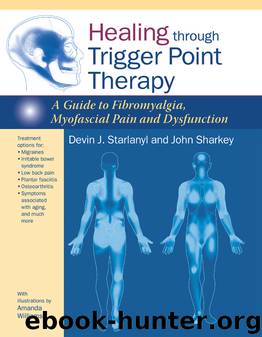Healing through Trigger Point Therapy by Devin J. Starlanyl

Author:Devin J. Starlanyl [Starlanyl, Devin J.]
Language: eng
Format: epub
ISBN: 978-1-58394-625-1
Publisher: North Atlantic Books
Published: 2013-10-22T04:00:00+00:00
Pectoralis Major and Sternalis
Latin pectoralis means “relating to the chest”; major, “larger”; sternalis, “relating to the breastbone” (from Greek sternon, meaning “chest”).
Pectoralis major.
Sternalis.
TrP referral pattern from intermediate sternal pectoralis major.
Lateral free margin.
TrP referral pattern from clavicular pectoralis major.
TrP area capable of causing cardiac arrhythmias.
In-doorway stretch.
What They Do: The pectoralis major elevates the chest in deep breathing, such as during respiratory distress. It helps stabilize the shoulder and rotate the upper arm medially (turning the palm facing inward), pulls objects down from above, and moves the arm forward and across the body (as when scratching the opposite elbow). The sternalis is a muscle remnant and continuation of the rectus abdominis.
Kinetics Comments: The pectoralis major is a climbing muscle, working with the latissimus dorsi to pull the body upward when the arms are overhead. It works hard during many martial arts, when pushing, punching, and throwing. Lymphatic drainage from the breast usually travels in front of, and around, the pectoralis major muscle to the axillary lymph nodes. Symptoms and signs of entrapped lymph vessels are often relieved by manual work on the pectoralis major. The sternalis isn’t present in most of us, but occurs frequently enough to cause confusion in manual examinations and imaging, especially mammography. This muscle lies on top of the pectoralis minor, and, depending on its shape, can be mistaken for pathological masses in the chest. Its shape is exceedingly variable; it can occur on only one side of the breastbone, or on both, and may be of any length.
TrP Comments: TrPs in the sternalis cause symptoms that result in many unnecessary tests for breast, heart, and lung disease. These TrPs can cause soreness over the breastbone and also deep pain beneath it that is intense enough to disturb sleep. They may be activated by a heart attack, and cause lasting pain until they’re treated. Their pain may be mistaken for a heart attack or angina. TrPs in both the pectoralis major and the sternalis can engage in a dangerous dance with cardiac disease, each worsening the other. TrPs on the right side of the pectoralis major, near the sternum, can be associated with cardiac arrhythmia, and successfully treating the TrPs may stop the arrhythmia. They usually cause pain as well as arrhythmias. TrP pain is usually more variable than angina in response to activity. TrPs do not exclude cardiac disease, and the reverse is also true. Tightness in the pectoralis major contributes to the round-shouldered, head-forward posture, and is often combined with weakness in the upper back muscles. TrP-shortened pectoralis major muscles can profoundly pull on the SCM. Release the pectoralis TrPs first, and the SCM may be easier to treat.
Any TrP that persists in spite of adequate treatment has a perpetuating factor, and some perpetuating factors are potentially deadly. When in doubt, check it out. Patients, take this book to the Emergency Department with you, as some care providers are still unaware that TrPs can mimic cardiac and other visceral problems. The issue may be in the tissue, not “all in your mind.
Download
This site does not store any files on its server. We only index and link to content provided by other sites. Please contact the content providers to delete copyright contents if any and email us, we'll remove relevant links or contents immediately.
Men In Love by Nancy Friday(5155)
Everything Happens for a Reason by Kate Bowler(4678)
The Immortal Life of Henrietta Lacks by Rebecca Skloot(4525)
Why We Sleep by Matthew Walker(4359)
The Sports Rules Book by Human Kinetics(4290)
Not a Diet Book by James Smith(3335)
The Emperor of All Maladies: A Biography of Cancer by Siddhartha Mukherjee(3064)
Sapiens and Homo Deus by Yuval Noah Harari(2987)
Day by Elie Wiesel(2719)
Angels in America by Tony Kushner(2595)
A Burst of Light by Audre Lorde(2546)
Endless Forms Most Beautiful by Sean B. Carroll(2431)
Hashimoto's Protocol by Izabella Wentz PharmD(2330)
Dirty Genes by Ben Lynch(2272)
Reservoir 13 by Jon McGregor(2242)
Wonder by R J Palacio(2137)
And the Band Played On by Randy Shilts(2129)
The Immune System Recovery Plan by Susan Blum(2027)
Stretching to Stay Young by Jessica Matthews(2000)
